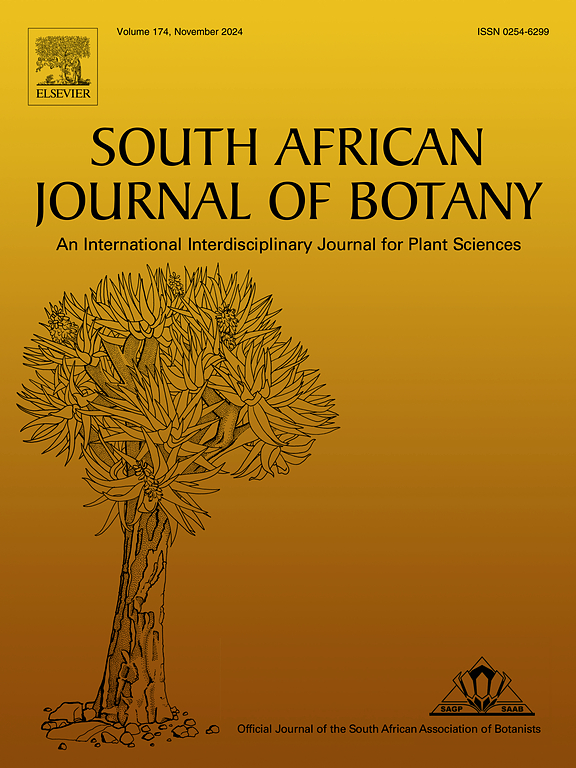Unveiling the anti-inflammatory power of Cajanus scarabaeoides seeds: In vitro evaluation, FTIR and LC-MS based analysis
IF 2.7
3区 生物学
Q2 PLANT SCIENCES
引用次数: 0
Abstract
The biological activity of various components of Cajanus Scarabaeoides holds considerable significance. This study aimed to evaluate the ability of C. scarabaeoides seed extracts to combat inflammation and identify their functional groups. In vitro assessments were conducted using human red blood cell (HRBC) membrane stabilization assays, specifically Heat-induced hemolysis, and Hypotonicity-induced hemolysis, to determine the anti-inflammatory efficacy. Additionally, the in vitro antiarthritic activity was evaluated through the Egg albumin denaturation assay. The identification of functional groups was accomplished using FTIR analysis. Results demonstrated that the crude methanol extract (CME) of seeds exhibited robust membrane stabilizing activity for heat-induced hemolysis (74.31 ± 0.55 %) at 1.0 mg/ml, surpassing the effectiveness of diclofenac sodium (41.05 ± 0.23 %), which served as one of the standards with half-maximal inhibitory concentration (IC50) of 546.14 ± 5.88 µg/ml. Similarly, in both hypotonicity-induced hemolysis and egg albumin denaturation assay, CME displayed the highest protective effect at 1.0 mg/ml (83.61 ± 1.91 % and 81.45 ± 0.18 % respectively) with an IC50 of 129.86 ± 12.05 µg/ml, surpassing aspirin, and diclofenac sodium in terms of hypotonicity-induced hemolysis (79.83 ± 1.99 % and 61.23 ± 1.65 % respectively) and egg albumin denaturation assay (36.46 ± 0.16 % and 59.31 ± 0.18 % respectively) with IC50 of 464.104 ± 6.19 µg/ml. All samples exhibited dose-dependent anti-inflammatory activity in HRBC membrane stabilization tests and antiarthritic tests. FTIR analysis revealed the presence of multiple functional groups in the tested seed extracts of C. scarabaeoides. LC-MS analysis of CME revealed the presence of 29 probable compounds. The findings of this study suggest that C. Scarabaeoides seeds possess anti-inflammatory and anti-arthritic properties, which implies that the plant's seed extract could be utilized in the treatment of inflammatory conditions.

揭示金银花种子的抗炎作用:体外评价、FTIR和LC-MS分析
金银花各成分的生物活性研究具有重要意义。本研究旨在评价金合冬种子提取物的抗炎能力,并鉴定其功能基团。体外评估采用人红细胞(HRBC)膜稳定试验,特别是热致溶血和低渗诱导溶血,以确定抗炎效果。此外,通过鸡蛋白蛋白变性试验评估体外抗关节炎活性。利用FTIR分析完成了官能团的鉴定。结果表明,种子粗甲醇提取物(CME)在1.0 mg/ml时具有较强的热溶血稳定膜活性(74.31±0.55%),超过双氯芬酸钠(41.05±0.23%),其半最大抑制浓度(IC50)为546.14±5.88µg/ml。同样,在hypotonicity-induced溶血和卵清蛋白变性试验,芝加哥商品交易所显示最高的保护作用在1.0毫克/毫升(83.61±1.91%和81.45±0.18%)的IC50 129.86±12.05µg / ml,超过了阿司匹林、双氯芬酸钠的hypotonicity-induced溶血(分别为79.83±1.99%和61.23±1.65%)和鸡蛋清蛋白变性试验(36.46±0.16%和59.31±0.18%)IC50为464.104±6.19µg / ml。所有样品在HRBC膜稳定试验和抗关节炎试验中均表现出剂量依赖性抗炎活性。FTIR分析表明,金银花种子提取物中存在多个官能团。LC-MS分析显示CME中存在29种可能的化合物。本研究结果表明,金龟子种子具有抗炎和抗关节炎的特性,这意味着该植物的种子提取物可用于治疗炎症。
本文章由计算机程序翻译,如有差异,请以英文原文为准。
求助全文
约1分钟内获得全文
求助全文
来源期刊

South African Journal of Botany
生物-植物科学
CiteScore
5.20
自引率
9.70%
发文量
709
审稿时长
61 days
期刊介绍:
The South African Journal of Botany publishes original papers that deal with the classification, biodiversity, morphology, physiology, molecular biology, ecology, biotechnology, ethnobotany and other botanically related aspects of species that are of importance to southern Africa. Manuscripts dealing with significant new findings on other species of the world and general botanical principles will also be considered and are encouraged.
 求助内容:
求助内容: 应助结果提醒方式:
应助结果提醒方式:


